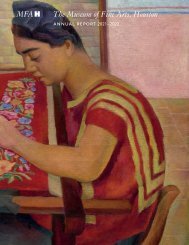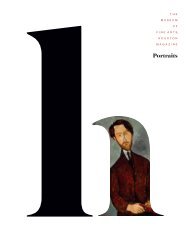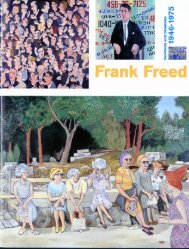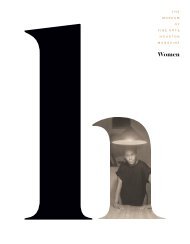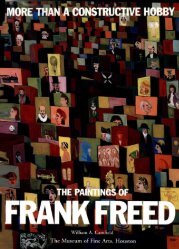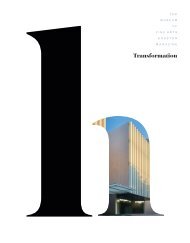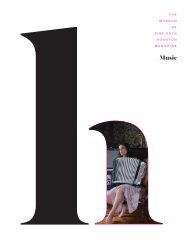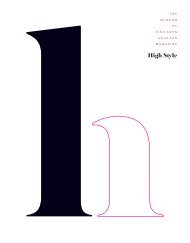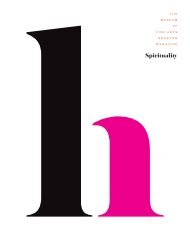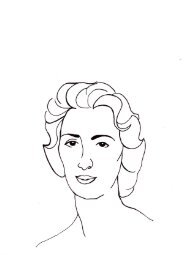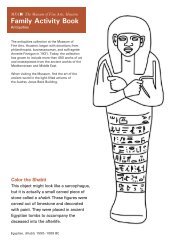Create successful ePaper yourself
Turn your PDF publications into a flip-book with our unique Google optimized e-Paper software.
<strong>The</strong> works shown here are among those featured in Golden Worlds: <strong>The</strong> Portable Universe of<br />
Indigenous Colombia, organized by the Los Angeles County Museum of Art, the Museum of Fine Arts,<br />
Houston, and the Museo del Oro of Banco de la República, Bogota, on view November 6, <strong>2022</strong>, through<br />
April 16, 2023, in the Art of the Indigenous Americas Galleries of the Caroline Wiess Law Building.<br />
Figuring and<br />
Adorning the Body<br />
in Ancient Colombia<br />
BY REX KOONTZ<br />
CONSULTING CURATOR OF ANCIENT AMERICAN ART<br />
<strong>The</strong> Indigenous people of Colombia produced some of the<br />
most finely crafted, deeply meaningful gold art objects in<br />
the Americas before the coming of the Spanish. Much of this<br />
exquisite metalwork represented or was meant to be worn<br />
on the body—or, at times, both. While seemingly straightforward,<br />
the relationship between art and the human figure is<br />
complicated by Indigenous ideas about the body, gold, and<br />
representation. In Indigenous traditions, gold is believed to<br />
transform its wearer. This power of transformation, rather than<br />
the exchange value of gold as money, was the concept that<br />
drove Indigenous creations in gold.<br />
To understand the European relationship to the Indigenous<br />
tradition of goldwork, many may recount the story of El Dorado,<br />
the fabled city of gold. <strong>The</strong> idea of a golden city galvanized<br />
many European explorers of the 16th century, among them<br />
Sir Walter Raleigh and a number of Spanish conquistadors.<br />
For the Indigenous South Americans of this time, however,<br />
El Dorado referred not to a city but to a man—one who was<br />
sanctified through a covering of gold dust and then bathed in<br />
the waters of a sacred lake. <strong>The</strong>se Native people believed that<br />
the beauty and splendor of goldwork was intimately tied to its<br />
role in sanctifying the human body. Through this ceremony<br />
and the wearing of the gold, the Indigenous South Americans<br />
believed a man was transformed into a powerful ruler.<br />
<strong>The</strong> works shown here, drawn from the Glassell Collection<br />
at the Museum of Fine Arts, Houston, demonstrate the significance<br />
and transformative power of gold in relation to the human<br />
figure in Indigenous culture before the arrival of Europeans.<br />
This pectoral (opposite), or chest ornament, is a superb<br />
example of the Calima style, one of the most complex and<br />
celebrated of ancient Colombian metalwork. This type of<br />
pectoral was made throughout the southwestern part of the<br />
country, from about 100 BC to AD 800. Scholars agree that<br />
these pectorals, when taken as a group, are some of the largest<br />
and most impressive gold objects made by ancient Colombian<br />
artists. <strong>The</strong> combination of a central raised relief and the more<br />
delicate linear decoration on the outside border is typical of<br />
this object type, but the example seen here is particularly<br />
well realized.<br />
A human face forms the center of the composition. Creating<br />
this face was a two-step process: the face was first sculpted in<br />
a hard material, probably a hardwood or stone; then, a flat<br />
sheet of gold was pressed onto the sculpture, creating a raised<br />
impression of the face on the sheet of metal.<br />
<strong>The</strong> raised face is adorned with nose and ear ornaments,<br />
imitating in miniature the gold ornaments worn by important<br />
Indigenous leaders. <strong>The</strong> nose ornament was fashioned from a<br />
single gold sheet in an inverted I-shape, with lightly embossed<br />
decoration. <strong>The</strong> ear ornaments were not adorned with such<br />
designs, however, allowing the viewer to focus on their perfect<br />
geometry.<br />
<strong>The</strong> central face is a highly conventionalized figure that is<br />
repeated throughout Calima art. Scholars have suggested that<br />
the figure could depict a god or an ancestor. While the central<br />
face follows the traditional model seen throughout Calima<br />
art, the geometric designs on the outer border are unique to<br />
S U R F A C I N G<br />
09<br />
8 3/4 × 11 × 1 1/8”




